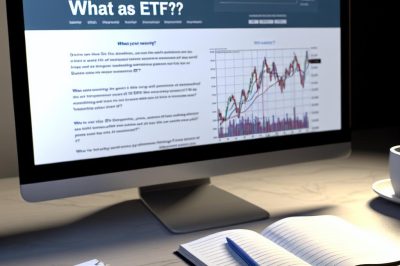Understanding ETFs
An Exchange-Traded Fund (ETF) is a financial instrument that represents an investment in an extensive array of securities. These securities, including stocks, commodities, or bonds, form an ETF that is traded on stock exchanges in a manner similar to stocks. This setup enables investors to buy and sell ETF shares within the trading day, in contrast to mutual funds which are tradable only at the end of the trading day.
Covered Call ETFs offer investors unique opportunities to generate additional income and manage risk through options strategies on ETF holdings. The widespread adoption of ETFs is attributed to the flexibility, cost-efficiency, and tax positivity they bring to a portfolio. Understanding the nuances of ETFs is crucial because they balance characteristics typical of both mutual funds and individual stocks.
Key Features of ETFs
The most notable feature of an ETF is its ability to combine attributes of mutual funds and stocks. Diversification is a central characteristic established through the comprehensive range of securities found within a single ETF. This approach reduces exposure to individual stock risks and provides an overarching engagement with the market’s movement. Unlike mutual funds, ETFs can be purchased and divested throughout the trading day, mirroring the behavior of individual stocks. This particular flexibility permits investors to leverage real-time price fluctuations, enhancing strategic investment approaches.
Trading Mechanism and Pricing
ETFs, trading under specific ticker symbols, are bought and sold on public exchanges. The ability to start trading when the market opens and continue until it closes is similar to the stock transactions. As such, ETFs have an underlying demand/supply mechanism that determines their market price. This often closely approximates the net asset value (NAV) of the underlying assets held by the ETF. The bid-ask spreads—the difference between buying and selling price—can influence liquidity and hence the trading strategy.
Types of ETFs
Various ETF types cater to diverse investor needs, enabling targeted asset allocation or market strategy.
Index ETFs
Index ETFs aim to replicate the performance of a specific benchmark index, such as the S&P 500 or NASDAQ Composite. By doing so, they offer investors low-cost exposure to a broad market segment, in line with the index’s allocation.
Sector and Industry ETFs
Thematic in nature, sector ETFs are geared towards particular segments such as technology, health, or finance. Industry ETFs narrow this focus down to niche sectors, further enabling precise portfolio exposure and strategic representation according to market analysis.
Bond ETFs
The inclusion of government, municipal, or corporate bonds provides an income and capital preservation approach in investment portfolios. Bond ETFs pay interest dividends and safe exposure to fixed income securities without requiring the investor to purchase individual bonds, which can sometimes be complex.
Commodity ETFs
Commodity ETFs track the performance of commodities like gold, silver, or fossil fuels, offering exposure to materials vital for economic activities without holding the physical commodity. Their pricing reflects the real-time changes in the commodity market, thus serving as a hedge against inflation.
Inverse and Leveraged ETFs
Optimized for traders, leveraged ETFs are structured to multiply the performance of an index, either positively or inversely. However, they require comprehension of derivatives and underlying markets as they might carry amplified risks and costs due to complex debt structures.
Advantages of Investing in ETFs
Investment in ETFs is naturally diversified, affording automatic exposure to a myriad of assets under one umbrella, which serves as a primary advantage in investor portfolios. This reduces specific asset risks and embraces wider market exposure.
Liquidity and Flexibility
ETFs are revered for their liquidity, allowing purchase and sale transactions to occur effortlessly within operational market hours. Portfolio liquidity provides investors the agility to pivot strategies in response to immediate market changes or data releases.
Cost Efficiency and Tax Benefits
ETFs boast lower expense ratios than mutual funds. This cost advantage stems from minimal management fees given their passive tracking designs. Moreover, the creation and redemption process generally result in reduced capital gains, positioning ETFs as a tax-efficient investment solution.
Potential Drawbacks
Despite their favorable traits, ETFs are not invulnerable and must be scrutinized before incorporation into investment plans. Active traders might encounter significant transaction fees due to commission fees, potentially curbing profitability if the strategy involves frequent market activities.
Tax Nuances
Tax scenarios for ETFs might appear favorable but can differ based on individual conditions and jurisdictions. Some ETFs might instead trigger significant taxable events, especially with regards to international obligations or dividend distributions. It is imperative to evaluate tax avenues aligned with personal financial environments.
Complex Investment Strategies
Specific ETFs might involve complex strategies, such as those related to derivatives in leveraged ETFs. These products may harbor latent risks that necessitate careful consideration and comprehensive understanding.
Conclusion
ETFs have emerged as a powerful instrument for constructing diversified investment portfolios, providing access to varied asset classes and strategies in a single trade. They are pivotal for enabling straightforward integration and management of a portfolio in line with desired risk profiles. Notwithstanding their versatility, potential investors should engage profoundly with ETF structures, expenses, and intrinsic risks. Becoming an informed investor is key to unlocking the potential advantages that ETFs offer within financial markets.
Exploring resources or professional guidance can enhance understanding of ETFs’ broad spectrum and aid in aligning them with investment objectives. Accessing structured platforms might delve deeper into the universe and nuances encompassing ETFs and other financial constructs.





